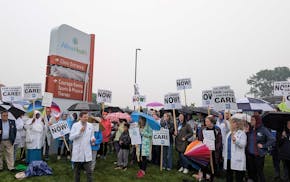The University of Minnesota said Thursday it wants to once again own its Minneapolis teaching hospital and then build a new medical center on its campus — a bold vision with few financial details but one requiring taxpayer money.
The push is meant to advance the U's leadership as a premier source of health care and medical research in Minnesota, officials said. It would also bolster the university's position as the state's only public medical school, responsible for training about 70% of the state's physicians.
It comes as Fairview Health Services — the Minneapolis-based nonprofit that partners with the U to run a prominent network of hospitals and clinics — is pursuing a merger with South Dakota-based Sanford Health.
The university has not supported the combination and it's not clear exactly how, and at what cost, the U would reacquire the University of Minnesota Medical Center from Fairview.
"We must own, govern and control the flagship health care facilities on our Twin Cities campus," said Joan Gabel, the University of Minnesota president, at a Thursday news conference. "We are calling on Attorney General [Keith] Ellison, Governor Walz and the Minnesota Legislature to support shifting these facilities to the university."
The U is calling its proposal MPact Health Care Innovation, with a new state-of-the-art medical center on the university's East Bank campus.
Significant planning work still is needed. Whenever construction would begin, it likely would take at least five years and cost no less than $1 billion, said Myron Frans, the U's senior vice president of finance and operations.
The university said it has been acquiring land for a new hospital for several years, designating a site at the eastern edge of campus. The medical center would be located adjacent to a large surgery center that the university operates in conjunction with Fairview.
The idea of a new hospital has been developing quietly at the U as a part of long-term planning.
The U said the vision will require short- and long-term partnership with elected leaders. That's because an unspecified amount of funding will be needed to shift ownership of the teaching hospital and pay for an interim upgrade to the facility.
"Given the age of our flagship East and West Bank hospitals and facilities, we have concerns about their ability to provide a platform for this world-class academic medical center," Gabel said. "So while the new hospital is under design and construction, we will seek legislative and community investment to bridge the present facilities to the future hospital."
Before any of that can happen, however, the U must orchestrate a complicated transaction with Fairview, which has owned the University of Minnesota Medical Center since 1997.
The deal to regain ownership of the teaching hospital would involve a shift of charitable assets with input from Ellison, Frans said.
"Remember they were transferred — they weren't sold — they were transferred as part of that 1997 [agreement]," Frans said in an interview. "So, this is unique — this is a different kind of model. Frankly, we're trying to sort out what that means, too. It's not a normal business model."
Earlier this week, Sanford and Fairview executives raised the idea of the U repurchasing the teaching hospital. The health systems say they want university support for their merger but would consider a sale of the teaching hospital at fair market value.
The U maintains, however, that such a valuation was not contemplated in the agreement with Fairview back in the '90s when it took control of the hospital.
The University of Minnesota Medical Center actually encompasses four somewhat distinct operations. It's possible a merged Sanford and Fairview may want to retain parts of it.
On the East Bank, there's the main teaching hospital as well as a large outpatient clinic and surgery center that opened in 2016. On the West Bank, there's Masonic Children's Hospital and an inpatient psychiatry service and an ER at the old Fairview Riverside hospital facility.
The university said Thursday it wants ownership of all four pieces. Sanford and Fairview said in a statement that the health systems have put "many options on the table, including the university repurchasing the east bank academic medical center."
"Since 1997, Fairview has invested significantly in capital improvements in both east bank, west bank and at Masonic Children's Hospital," the health systems said.
The Sanford-Fairview merger would create a health system with more than 50 hospitals across Minnesota and the Dakotas. Fairview provides more than $80 million in financial support per year for academic medicine at the university, although that's just one part of a complex financial relationship that includes the shared M Health Fairview brand.
U medical school dean Dr. Jakub Tolar and other university officials have expressed concern over the Sanford-Fairview merger proposal, calling it more focused on business interests than on research, medical education and patient care at the U.
Ellison said this week he understood the merger could be completed by the end of March, but Frans said he thinks that timeline is too fast. It shouldn't be allowed to happen, he said, until the U's concerns have been addressed.
For now, the affiliation agreement between the U and Fairview continues through 2026, although Frans said it's possible that "maybe we come to something new between now and then." The U could also create a new long-term affiliation with multiple health care providers in Minnesota.
Fairview provided a financial bailout of the U hospital in the '90s, when the medical center was struggling financially. But today, running a teaching hospital is "a good business," Tolar said.
"I mean, it's a noble thing to do as well," he said during the news conference. "And, in my opinion, it's life-affirming and it builds lives and livelihoods ... but it's also a very good business."

Bushel Boy, Minnesota's local tomato grower, sold
After 60 years, federal cuts shutting down Job Corps center in St. Paul

In a first, Minnesota doctors walk their own picket line, then hustle to see patients
It's harder to find a job this year, especially a corporate position

